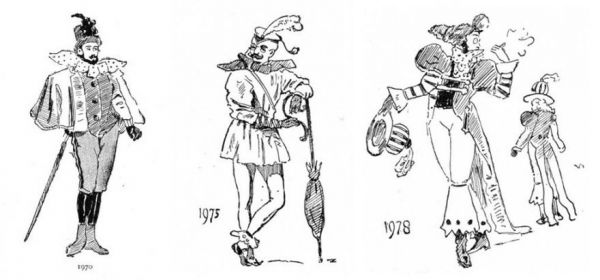The Funniest Guy in the World

by Eddie Deezen
He was born Jerome Lester Horwitz in Brooklyn, New York, on October
22, 1903. Born to Solomon and Jennie Horwitz, Jerry was youngest of the
five Horwitz (later Howard) brothers. Up until he became a world-famous
“Stooge,” his life was fairly uneventful.
Young Jerry was a
mediocre student and was fairly quiet and unobtrusive. He played and
excelled on the school basketball team. While his older brothers, Shemp
and Moe, were playing Vaudeville houses and cutting their teeth as
comedians, Jerry graduated from public school and sort of drifted
around, trying to find himself.
By the mid-1920's, Jerry had
managed to score a steady gig conducting the Orville Knapp Band. It was a
comedy bit of shtick, where Jerry would conduct the band, and as he
did, bits of his clothing would fall off, until at last he was left
standing in a big diaper. At the age of 29, he replaced his older
brother “Shemp", as the third stooge in the Three Stooges slapstick
comedy act.
Shemp, Moe, and a frizzle-haired violinist named
Larry Fine had made up a comic trio for several years, along with their
leader at the time, a man named Ted Healy. But by 1932, Shemp decided he
wanted to try making it on his own and left the act. Jerry was brought
into the act and, according to Moe, for his first two weeks as a Stooge,
all he did was run around barefoot on stage, carrying a bucket of
water.
Jerry
had spent the early years of his life with thick, brown curly hair and a
big mustache. When he joined the act, the first step was shaving off
the facial hair and cutting off all his hair. The story goes that Jerry
actually was crying when they cut his hair off.
“If
you want me, call me ‘Curly,’ he said, and his lifelong (soon
world-famous) monicker was set. Being the youngest of five children in
the Howard household, he was known lovingly as “Babe." Another version
of the “Curly" derivation story has Ted Healy seeing Jerry with a shaved
head and saying, “Don't you look girly.” Moe misheard him and thought
he said “Curly' and the new nickname was soon adopted.

Although
not as wild and boisterous, Curly really was a lot like the character
he played in the Stooges' shorts- childlike, emotional and excitable. He
loved dogs, buying a new one in every new city he visited. Once, when
he and Moe were walking down the street, Curly's dog was hit by a car
and killed. Curly became hysterical. Moe, thinking fast, ran to his
house and gave Curly his dog. This settled Curly down and he was
alright.
Curly and his older brother Moe always had a extremely
close relationship. Curly had no financial sense at all, and Moe would
help him with his finances and do his income taxes every year.
Curly
lived his entire adult life in severe pain. At the age of 12, he had
accidentally shot himself in the leg in a hunting accident. The bone did
not set properly, and for the rest of his days, Curly had trouble with
the leg. If you watch a Three Stooges movie and see Curly running, you
will see a very noticeable limp.
This chronic pain he suffered
had another bad effect: it caused Curly to drink. It is disputed whether
or not Curly was a full-fledged alcoholic, but he did like his alcohol.
Curly
had one other major weakness: he loved women. Any good-looking woman
with a good approach would latch onto Curly and he was more than happy
to spend his money on her. Curly was actually married four times. His
first marriage was annulled and he got two divorces. He finally found
happiness with his fourth and final wife, Valerie, but more on that
later.
After
making a few mediocre shorts and films at MGM studios with Ted Healy,
the boys and Healy decided to part and go their own ways. After signing a
new contract with Columbia Studios in 1934, Curly, Moe, and Larry
quickly found their comic identities. Moe, dispensing pies, slaps and
eye pokes, took over the act's "leader" role from the departed Ted
Healy, while Larry became the nondescript middleman in the act.
Curly's
comic character became fully fleshed out and nothing quite like him has
ever been seen on the movie screen- before or since. Curly was a
surreal kind of man-child. To everyone's happy surprise, it was quickly
discovered that Curly was a master of invention and was a virtuoso at
slapstick comedy. He had a zest and enthusiasm for life and all of it's
adventures. He was Moe's most frequent target for a slap, a poke in the
eyes, or a pie in the face.
Curly's
trademark excited yelps of 'woob woob woob,” his dog barks, his
compliant “Soitenlys,” and his brisk face washes (where he is excited
and smooths his hands up and down over his face, briskly, over and over)
were loved- and happily expected- by his legions of fans.
Curly
was what Moe called a "slow study,” meaning he simply couldn't remember
lines very well. One day, Moe watched as Curly forgot his line in a
scene. As Moe recalled, "his eyes rolled back, he fell on the floor and
started spinning around like a top." And thus, the “Curly spin" was
born.
Jules White, the director of dozens of Three Stooges
shorts, was a stickler for detail and did not like any ad-libbing in the
films he directed. But, recognizing the genius of Curly, White would
direct him by saying, “Look, you do whatever you want. I know you'll be
great.”

Throughout
the 1930s and well into the ‘40s, the Stooges churned out classic
comedy films, which continue to delight audiences, around the world, to
this day. But by the early 40's, Curly's health rapidly deteriorated.
Curly
loved to go out dancing and drinking and most of all, he loved smoking
cigars. He definitely did not take care of himself, and like a child,
was always just looking for the next good time. In the mid-1940s, he was
admitted to the hospital with very high blood pressure and he had a
series of strokes. As any Stooge fan well knows, it is sad to watch
Curly's last few Stooges shorts, because he looks so anemic and wasted.
His trademark high energy and vitality seems almost gone.

Curly
had trouble remembering any of his lines, and there are memories of
brother Moe, slowly and patiently, going over Curly's lines with him,
one by one, before an upcoming scene- as an adult might rehearse with a
child.
Finally, on May 6, 1946, the final, sad moment occurred. As the Stooges were filming their 97th short together,
Half Wit's Holiday,
Moe went over to get Curly for his next scene. He found Curly slumped
in a chair with his head on his chest. Curly had had a major stroke, and
this one was the end of his career as the third Stooge.
Curly
was rushed to the hospital, not knowing that his movie career was over.
Curly's older brother, Shemp, replaced him in the act and in the films.
Shemp, an undisputedly good comedian, just never could really replace
the great Curly in the hearts of millions of Three Stooges fans. As
movie critic Leonard Maltin so aptly put it: “Shemp just couldn't
replace Curly's other-worldliness".
As Curly was now "retired"
and without any income, brothers Moe and Shemp volunteered to give a
percentage of their weekly pay to their kid brother. Larry Fine,
although not related, immediately offered to give a portion of his
salary to his old partner, too.
Curly
lived out his final days with his new wife, a woman named Valerie
Newman. Happily, Curly finally found that "great love" he had looked for
all of his life. Valerie deeply loved Curly (unlike his previous
three wives) and would nurse him in his chronic illness, 24 hours a
day. She would even bathe poor Curly as his body atrophied.
Curly's
health grew worse and worse until finally he was committed to a
sanitarium. Moe would often visit and remembers how on his final visit,
Curly was so weak, he could only communicate by squeezing Moe's hand.
The
reality of this incredibly vital, life-of-the-party, comedic genius
dying in such a slow, cruel fashion is sadly ironic. Jules White was to
remember visiting Curly in the hospital during his final days. As he and
Curly were chatting and reminiscing, Curly looked up wistfully and
said, “Gee Jules, I guess I'll never be able to make the children laugh
again, will I?”
Curly Howard finally passed away on January 18, 1952. He was barely 48 years old.
Happily,
Curly Howard is now recognized by countless comedy critics as one of
the finest comedians in movie history, many ranking him along with
Charlie Chaplin, Buster Keaton, and the Marx Brothers. The Three Stooges
are beloved around the globe by their devoted fans and Curly Howard is
the indisputable most popular Stooge of all-time.



 by Eddie Deezen
by Eddie Deezen








